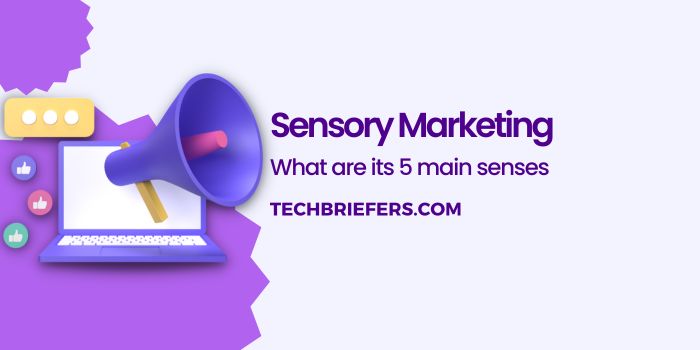What is Sensory Marketing and its 5 Main Senses

Amid the various digital marketing techniques or methods currently available, there are also many theories about the best way to attract customers. One popular method is sensory branding or marketing that utilizes human sensors.
Sensory marketing, also known as sensory advertising, is a way to appeal to your audience’s five senses using sensory appeal. This type of marketing focuses on creating content that uses the senses of sight, touch, sound, smell, and taste.
Branding or multi-sensory marketing has proven to be an effective way to capture audience interest and make your brand/business unforgettable. Some people enjoy seeing visuals, others like listening to audio, while others are drawn to touch or smell so these sensory appeals can all be used in marketing products and services.
In the short article below, you will see how this marketing plays an important role in digital marketing which is now a modern marketing technique.
Get to know the definition and meaning of Sensory Marketing
Simply put, sensory marketing involves implementing marketing campaigns that appeal to the audience’s five senses namely sight, sound, touch, taste, and smell. This marketing involves many techniques used to reach your customers’ senses and influence their behavior based on how your brand and tactics lead them to ultimately purchase your product.
Using media sense in advertising and marketing campaigns can greatly influence your audience and their decision to purchase your product. Research has shown that certain sensory appeals can influence how a person perceives an object or activity when associated with that sensory experience.
Appealing to and effectively using the human senses in promoting products to consumers is why sensory advertising can achieve great results. Sense marketing is a simple but effective approach to influencing consumers to buy a product or service.
Also Read: Influencer Marketing: How online influencer marketing works?
5 Main Senses of Sensory Marketing
New research on the concept of embodied cognition shows that human bodily sensations aid in decision-making without the human being consciously aware. By utilizing sensory marketing, marketers have the opportunity to capitalize on this area to connect more with consumers, in a world full of advertising and visual business campaigns. Below are the 5 basic senses that are the basis of this marketing.
#1. Taste or flavor
Taste consists of several sensations that are used to assess the taste of a product. By incorporating flavors into sensory marketing, you have to think outside the box where sampling is a basic technique that is widely used. To better implement this understanding, you must create an experience.
#2. Sight or vision
Sight is the most stimulated of the 5 senses in sensory marketing. Consumers easily recognize logos, names, and color schemes. As a marketer, you can also combine sight with sound, to create lasting emotional experiences for consumers. Technology allows marketers to utilize digital technology to create experiences for consumers.
#3. Smell or Odour
Have you ever noticed a distinct, distinctive aroma in a retail store or a fresh scent that fills your local supermarket? This is no coincidence as stores use the sense of smell to connect consumers with positive memories and experiences. A smell can be used to encourage customers to fall in love with a product.
#4. Sound or hearing
Sounds are widely accepted in all common areas of marketing from traditional jingles and slogans to signature sounds and ambient music. Research shows that music is used to regulate our emotions. Varying tempo, volume, and tone can influence consumer perception. Incorporating music into sensory marketing will help in carrying out comprehensive marketing activations.
#5. Touch or Touching
Touch is one of the 5 sensory marketing senses that is difficult to receive through digital marketing tactics. This technique will be very suitable in offline marketing or physical stores so that it can provide your customers with a direct experience. Whether it’s the textures you use in your packaging or the materials in your products, the nuances of your brand and business can resonate with customers on an intimate level because of this sense of touch.
Also read: How to Create a Business Marketing Plan?
Sensory Marketing Methods, Tactics and Strategies

If you take the time to explore the latest sensory marketing research, you’ll find that this strategy is all about creating an intimate connection with your audience or customers. Traditional, classic mass marketing strategies can rarely produce the same impact, because they work on the assumption that people will behave logically when faced with purchasing choices.
In contrast, the science of sensory marketing shows that people as consumers will act according to their emotional urges, more often than objective reasoning. Here are several methods and tactics in the strategy that you can apply to help your business’s marketing success.
- Determine your brand personality and target buyers
- Work with design experts who have been trained in using the 5 senses of sensory marketing
- Find your business voice and personality
- Involves the limbic system which influences the brain and emotional responses
- Don’t underestimate the offline experience even though online stores are currently more popular
Also Read: Online Business Definition | Online Business Types and Benefits
Application of Sensory Marketing to Support Business
Sensory marketing is a great way to provide a unique and holistic customer experience. But purely from a marketing perspective, the technique can also have some impressive results because sensory marketing can be used as a means to facilitate experiential marketing.
Experiential marketing itself involves and offers experiences to consumers as a means of advertising your product or brand. this technique is one of the most popular marketing trends in recent years and sensory marketing is an integral part of a great experiential marketing campaign.
Additionally, sensory marketing can be leveraged to guide consumers more effectively through the entire buyer’s journey. For example, a store might use an irresistible aroma to draw customers inside and play pleasant music in the background once they enter, encouraging them to come inside.
Also Read: The Power or Advantages of Digital Marketing
Conclusion and Conclusion
Businesses can also make their displays and decor visually appealing with lots of textures and materials to keep browsing engaged and offer free samples to build rapport and give them that final push to buy.
Of course, sensory marketing can help build the brand and business you want. Considering that many businesses have different varieties and types, all of these businesses will have very different branding needs. Adopting a 5 senses approach to your branding and marketing strategy can help solidify the specific vision you have for your brand and business in the minds or memories of your customers.

Leave a Reply